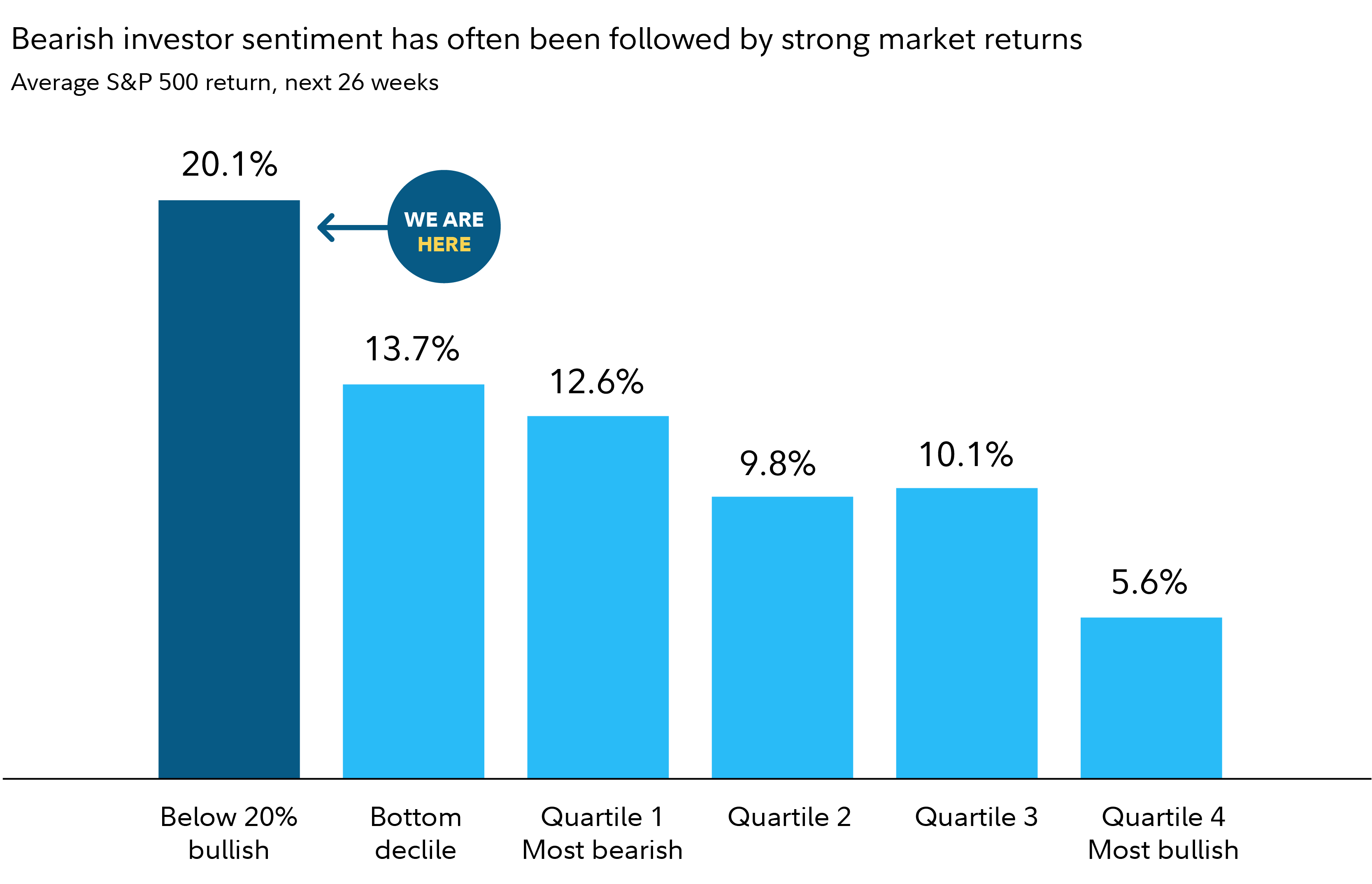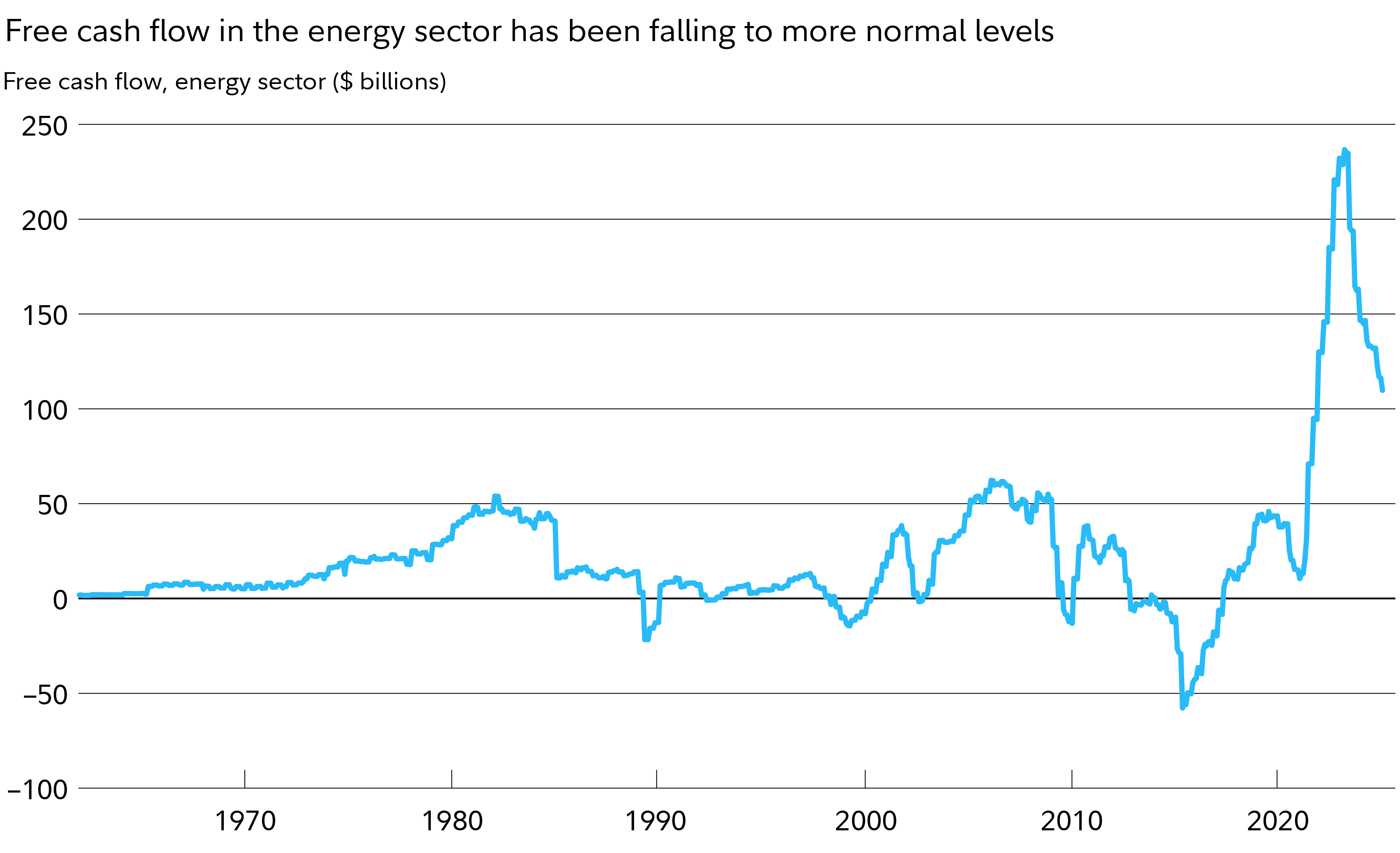Markets are still trying to find their footing, following the 2-week burst of volatility earlier this month. But with the S&P 500® Index still in correction territory, there’s no question that the mood of the market looks darker. Investors are still digesting the month’s various announcements on trade policy, and bracing for the possibility of more changes ahead, all of which add up to a more uncertain outlook for economic growth, corporate profits, and inflation.
But investors should remember that in markets, the darkest hour is usually just before dawn. Historically, markets tend to bottom when the news is at its worst, then rise as the news gets slightly less bad.
While there’s no guarantee that things couldn’t get worse from here, my research suggests investors shouldn’t abandon stocks—and that in fact, the current negative mood could be a positive indicator for stocks’ future returns. That said, some parts of the market may have better prospects than others.
Here’s more on 3 key themes for investors to consider now.
1. Poor sentiment can be a "buy" signal
The events of the last few weeks and months may feel unprecedented—extreme events often do. My research focuses on analyzing historical market data to uncover patterns and probabilities that have been predictive through market history. This can help challenge investors’ biases during stressful market events and provide a more objective backdrop for decision-making.
Recently, some of the strongest signals turning up in my research have been contrarian indicators. These signals seem negative, but they often show that the market has already priced in a lot of bad news, increasing the odds of future market gains.
Investor sentiment is one such contrarian indicator. Even before the tariff announcements this month, individual investors had started turning markedly bearish. Starting in February, less than 20% of members surveyed by the American Association of Individual Investors said they were bullish on the stock market. That was near the bottom of the survey’s historical range, representing an extreme that occurs only about 2% of the time. It also represented the fastest bullish-to-bearish reversal since the 1990 Gulf War.
In previous instances when sentiment has dropped to similar levels, the S&P 500 has gone on to gain an average of about 20% over the following 6 months.

Lack of clarity about trade policy may be another contrarian signal. Uncertainty around trade policy spiked to an all-time high last month, based on an index that tracks mentions of trade policy uncertainty in major newspapers. Investors may worry that the lack of clarity around trade policy will hurt stocks’ subsequent returns, but historical data suggests the opposite—possibly because the market can price in this uncertainty so quickly. Since 1990, higher trade policy uncertainty has correlated with higher risk-adjusted stock returns over the next 12 months.
It’s always possible that “this time is different,” but investors should also ask themselves: What if it’s not?
Read the full report
Get Fidelity’s complete Q2 2025 Quarterly Sector and Investment Research Update, from the desk of Denise Chisholm, director of quantitative market strategy.
Download the full report (PDF).2. Trends in lending could be positive for 2 sectors
The outlook for business lending improved early in 2025. As of January, far fewer small businesses reported that credit had become harder to get, according to surveys of small businesses from the National Federation of Independent Business. In the past, when this measure fell to the bottom 25% of its range, as it did recently, loan growth tended to accelerate over the next 12 months. Loan growth has been historically weak in recent years, so an acceleration in lending could be a welcome development for the economy and the stock market.
Shares of real estate investment trusts (REITs) could be a beneficiary of this growth. REITs rely heavily on debt to finance operations and have historically benefited from easier credit.
Another could be financial stocks. Since 1978, when loan growth has accelerated from near the bottom of its historical range, financial stocks have gone on to outperform the broad market by 3.3 percentage points over the following 12 months, on average.
The financial sector also offers low valuations—with valuations recently in the bottom quartile of their historical range—that may provide a floor for the stocks if the news turns out to be worse than expected. If you are worried about a recession, one way to potentially reduce risk is to look for sectors that have already priced in a recession. Financials is one of those sectors.
3. Be cautious about energy stocks
Energy stocks have underperformed significantly since 2023, lagging the S&P 500 by more than 20 percentage points over the year through mid-April.
Bargain-hunting investors may wonder if this situation presents an opportunity to buy, but historical data urges caution. After previous 12-month periods when energy trailed the broad market by more than 15 percentage points, the sector continued to lag over the next 12 months, on average.
Energy’s recent challenges may represent a return to greater normalcy, following a massive surge in free cash flow that the sector experienced coming out of the COVID pandemic. The sector’s free cash flow has declined steadily for more than 2 years, but as of earlier this year it was still at a level more than double its previous peak, suggesting there could still be more room to fall.

When energy’s free cash flow growth has been in the bottom half of its historical range, the sector has underperformed the market by an average of 1.2 percentage points over the next 12 months.1
How to search for investing ideas
Based on this analysis and other research, I believe the current market environment is not a time to abandon stocks. Rather, the outlook for stock returns—particularly for longer-term investors who can withstand any additional near-term volatility—could be bright. Investors may want to look to the financial and real estate sectors for potential opportunities.
Investors interested in matching investing ideas to these themes can search for financial and real estate stocks using the Fidelity Stock Screener . Or, to search for mutual funds or ETFs that focus on these sectors, investors can use the Fidelity Mutual Fund Research tool or ETF Screener .

Denise Chisholm is director of quantitative market strategy in the Quantitative Research and Investments (QRI) division at Fidelity Investments. Fidelity Investments is a leading provider of investment management, retirement planning, portfolio guidance, brokerage, benefits outsourcing, and other financial products and services to institutions, financial intermediaries, and individuals.
In this role, Ms. Chisholm is focused on historical analysis, its application in diversified portfolio strategies, and ways to combine investment building blocks, such as factors, sectors, and themes. In addition to her research responsibilities, Ms. Chisholm is a popular contributor at various Fidelity client forums, is a LinkedIn 2020 Top Voice, and frequently appears in the media.
Prior to assuming her current position, Ms. Chisholm was a sector strategist focused on sector strategy research, its application in diversified portfolio strategies, and ways to combine sector-based investment vehicles. Ms. Chisholm also held multiple roles within Fidelity, including research analyst on the mega cap research team, research analyst on the international team, and sector specialist.
Previously, Ms. Chisholm performed dual roles as an equity research analyst and director of Independent Research at Ameriprise Financial. In this capacity, she focused on the integration of differentiated research platforms and methodologies. Before joining Fidelity in 1999, Ms. Chisholm served as a cost-of-living consultant for ARINC and as a Department of Defense statistical consultant at MCR Federal. She has been in the financial industry since 1999.
Ms. Chisholm earned her bachelor of arts degree in economics from Boston University.



